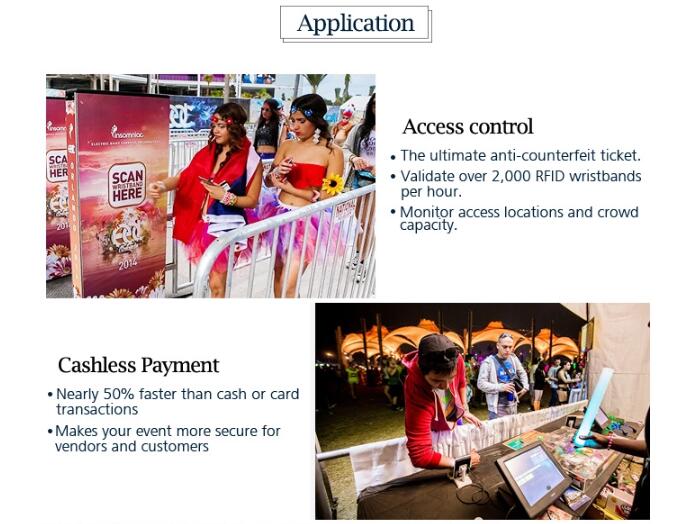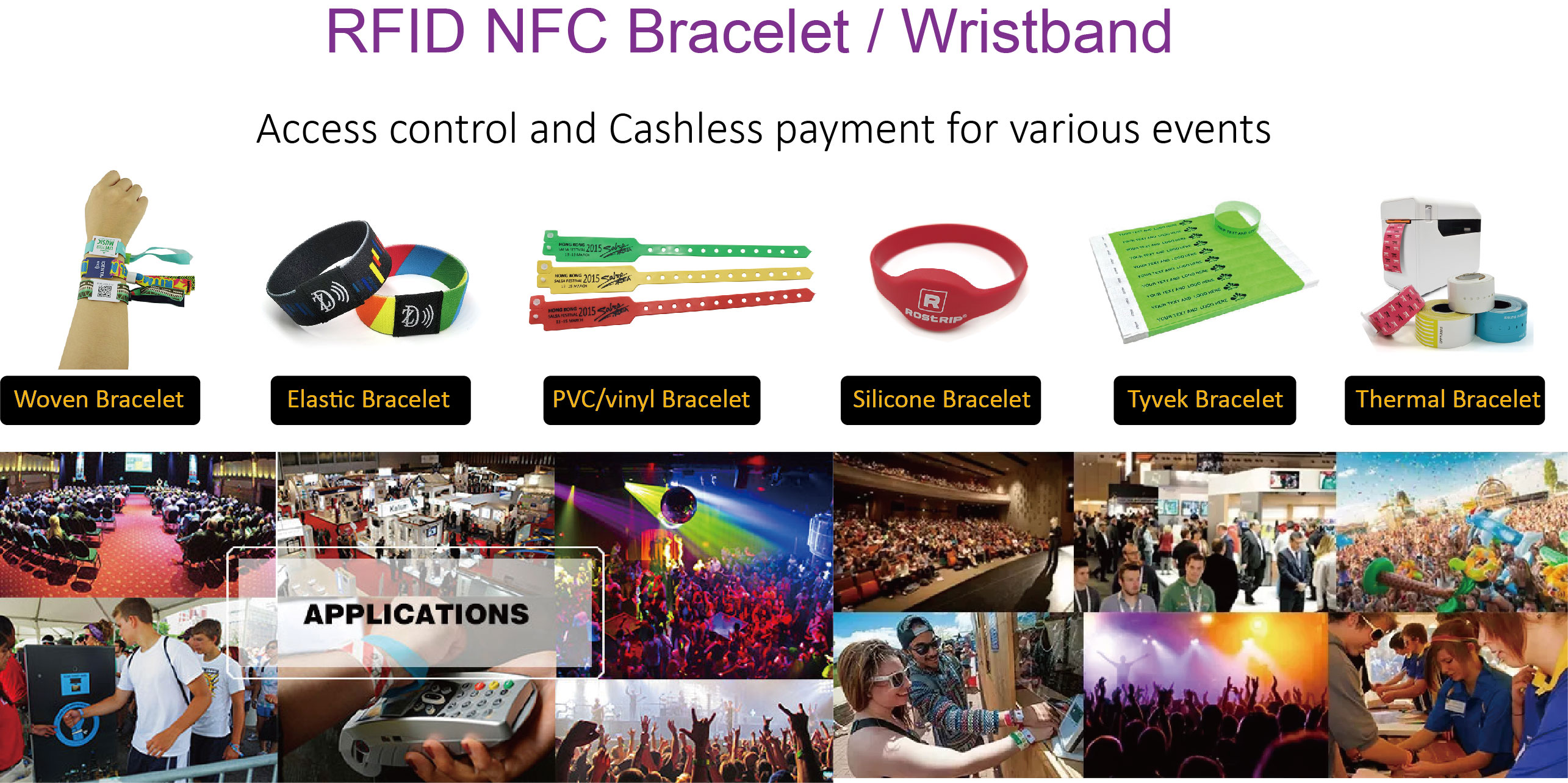In recent years, RFID wristbands have emerged as a game-changing tool for modern event management. From large-scale music festivals and high-stakes sports tournaments to intimate corporate conferences and bustling theme parks, Radio Frequency Identification (RFID) technology is redefining how organizers handle access control, streamline payments, and elevate guest experiences.
This shift isn’t just about adopting new tech—it’s about solving longstanding pain points, like slow check-ins or cash-handling delays, while unlocking new opportunities to engage attendees. Let’s dive into how RFID wristbands are used across event types, their core benefits, and why they’ve become indispensable for seamless, smart event operations.
RFID wristbands are wearable devices embedded with a tiny RFID chip and a small annna. They operate by communicating wirelessly with RFID scanners or readers—when held near a reader (usually within 1–3 inches), the chip transmits stored data (such as entry rights, payment balances, or attendee IDs) for instant verification.
Their design and material vary based on event needs:
• Silicone: Durable, waterproof, and reusable (ideal for multi-day festivals or theme parks).
• Fabric: Lightweight, comfortable, and often single-use (common for concerts or one-day conferences).
• PVC: Cost-effective, customizable, and suitable for both short-term events and repeated use with reprogramming.
Unlike traditional tickets or plastic cards, wristbands are hands-free, hard to lose, and impossible to transfer (many are tamper-proof, with locks that break if removed improperly).

The widespread adoption of RFID wristbands stems from their ability to solve key challenges for both organizers and attendees. Here are the five most impactful advantages:
Long check-in lines are one of the biggest frustrations for event-goers—and RFID wristbands eliminate this pain point entirely.
• Attendees simply tap their wristband against a scanner at the entrance; verification takes less than a second.
• Paper tickets (which are easy to counterfeit or lose) become obsolete—each RFID chip has a unique, uncopyable ID that links directly to the attendee’s registered ticket.
• For multi-zone events (e.g., a festival with VIP areas or a conference with separate sessions), wristbands can be programmed to grant access only to authorized areas, preventing gatecrashing.
RFID wristbands turn attendees’ wrists into “mobile wallets,” transforming how transactions work at events.
• Attendees load money onto their wristband (via an app, website, or on-site kiosk) and tap to pay for food, drinks, merchandise, or even ride tickets.
• This cuts down transaction time by 50% or more (no fumbling with cash, cards, or phone apps) and reduces theft risks for vendors (less cash on hand).
• Organizers often see a 15–30% increase in on-site spending—attendees tend to spend more freely when they don’t have to handle physical money.
RFID technology lets organizers move beyond “one-size-fits-all” events and create tailored interactions for attendees.
• Wristbands can be linked to attendee profiles (e.g., social media accounts, loyalty program data, or dietary preferences). For example, a music festival might use the wristband to auto-share photos from a photo booth to an attendee’s Instagram.
• VIP attendees can get instant upgrades (e.g., access to a backstage lounge or priority entry to a concert) without extra tickets—their wristband already holds the authorization.
• Some events use RFID for gamification: attendees tap their wristbands at checkpoints to earn points, unlock rewards, or compete with others, boosting engagement and fun.
For organizers, RFID wristbands are a goldmine of actionable data that improves event operations—both during and after the event.
• Real-time tracking shows attendance flow (e.g., which stages are overcrowded at a festival) and popular zones (e.g., a food truck with long lines), letting staff redirect resources (like adding more vendors) on the spot.
• Post-event analytics reveal spending patterns (e.g., which merchandise sells best) and attendee behavior (e.g., how long guests stay in each area), helping organizers refine marketing strategies and event layouts for future editions.
RFID wristbands aren’t just functional—they’re a powerful branding tool and a keepsake for attendees.
• Organizers can fully customize wristbands with event logos, sponsor names, colors, or even QR codes (linking to event apps or social media). This turns every attendee into a walking advertiser.
• Many attendees keep their wristbands after the event as collectibles (especially silicone ones from festivals like Coachella or Tomorrowland). This extends brand exposure long after the event ends.
RFID wristbands adapt to nearly any event format, with use cases tailored to specific needs. Here’s how they’re transforming key industries:
Large festivals (e.g., Coachella, Tomorrowland) were early adopters of RFID wristbands—and for good reason.
• Access: They handle check-ins for 100,000+ attendees per day, reducing lines from hours to minutes.
• Payments: Attendees tap to buy beer, snacks, or band merch, eliminating cash-related delays at busy stalls.
• Engagement: Some festivals link wristbands to social media—attendees tap at “share stations” to post photos or videos with event hashtags, boosting online visibility.
RFID wristbands serve both athletes and fans at sports gatherings.
• Athletes: For marathons or triathlons, wristbands track split times (via scanners along the course) and automatically send results to participants’ phones post-race.
• Fans: Wristbands grant access to stadium seats, VIP lounges, or locker room tours—and let fans pay for concessions without missing game action.
Conferences use RFID wristbands to simplify logistics and boost sponsor value.
• Registration: Attendees skip long lines by picking up pre-programmed wristbands, which double as session passes (scanned to track which workshops they attend).
• Sponsors: Wristbands let sponsors collect leads—attendees tap at booths to share contact info (with permission), replacing paper sign-up sheets.
• Networking: Some events use wristbands to connect attendees with similar interests (e.g., a “tap to exchange LinkedIn details” feature).
Theme parks have turned RFID wristbands into “all-in-one” guest tools—Disney’s MagicBand is the most iconic example.
• Access: Wristbands act as park tickets, ride reservations, and hotel room keys.
• Payments: Guests tap to buy food, souvenirs, or photo packages, linked directly to their resort account.
• Personalization: Disney’s MagicBand syncs with its app to greet guests by name, track FastPass+ reservations, and even trigger character interactions (e.g., a princess waving when a guest’s band is scanned).
High-end events (e.g., corporate galas, celebrity parties) use RFID wristbands for exclusivity and security.
• Authentication: Wristbands verify guests against a pre-approved list, preventing uninvited attendees from entering.
• Customization: Luxury events often use premium materials (e.g., leather-trimmed silicone) with embossed logos for a high-end look.
• Activations: Wristbands can be linked to photo booths or champagne service—guests tap to unlock perks, enhancing the VIP feel.

RFID technology isn’t standing still—its next phase will bring even more integration and personalization to events.
• Hybrid Systems: With NFC-enabled smartphones, many events now offer a choice: use an RFID wristband or a digital pass stored on your phone. Both work with the same scanners, giving attendees flexibility.
• Biometric Integration: Future wristbands may combine RFID with biometrics (e.g., fingerprint or heart rate sensors) for extra security (e.g., preventing wristband theft) or personalized experiences (e.g., adjusting ride intensity based on heart rate).
• AI and IoT Connectivity: RFID data will pair with AI to predict crowd flows (e.g., alerting staff to a bottleneck before it happens) or personalize recommendations (e.g., suggesting a band based on an attendee’s past festival choices).
• Sustainability: Brands are developing eco-friendly RFID wristbands—made from biodegradable silicone or recycled fabric—to align with event sustainability goals (e.g., zero-waste festivals).
Q1: How do RFID wristbands work, exactly?
A1: Each wristband has a small chip and antenna. When held near an RFID reader, the reader sends a radio wave signal that powers the chip. The chip then transmits its unique data (e.g., ticket status, payment balance) to the reader, which verifies it instantly.
Q2: Are RFID wristbands reusable?
A2: It depends on the material. Silicone and PVC wristbands can be reprogrammed (erasing old data and adding new) for multiple events. Fabric wristbands are usually single-use, as they’re less durable and often designed as souvenirs.
Q3: Is my personal or payment data safe on an RFID wristband?
A3: Yes. Most RFID systems use encryption to protect data—payment info is stored on secure servers (not the chip itself), and the chip’s unique ID can’t be duplicated. Tamper-proof designs also prevent someone from removing the chip to access data.
Q4: How much do RFID wristbands cost for an event?
A4: Prices range from 3 per wristband, depending on material (fabric is cheaper, premium silicone is more expensive) and chip type (basic RFID vs. high-security encrypted chips). Bulk orders (10,000+ units) often get discounts.
Q5: Can RFID wristbands be customized for my event?
A5: Absolutely. You can add custom colors, logos, sponsor names, QR codes, or even unique designs (e.g., a festival’s mascot). Many providers also offer variable data printing (e.g., printing an attendee’s name on their wristband).
RFID wristbands have moved beyond “nice-to-have” to “essential” for modern event management. They solve logistical headaches (long lines, cash theft) for organizers, while giving attendees a smoother, more personalized experience—whether they’re tapping into a concert, paying for a theme park snack, or networking at a conference.
As events continue to embrace digital transformation, RFID wristbands won’t just be a tool—they’ll be the backbone of smart, connected experiences that keep attendees coming back.
Need customizable RFID wristbands for your next event? Contact us today for a tailored RFID solution that fits your event’s size, goals, and budget.
Do you need a professional team to provide you with solutions? Contact us for a quote
Let us discuss it with you.